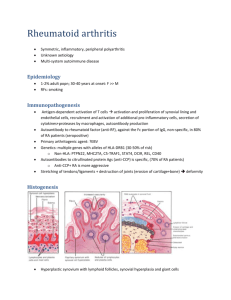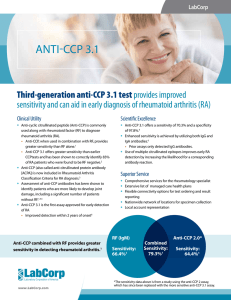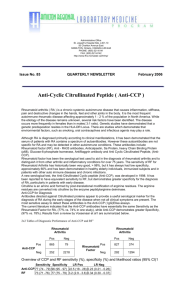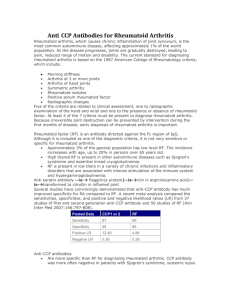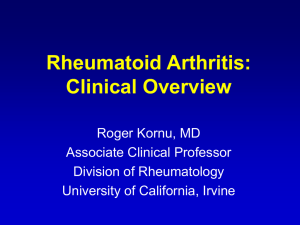Specific autoantibodies precede the symptoms of
advertisement
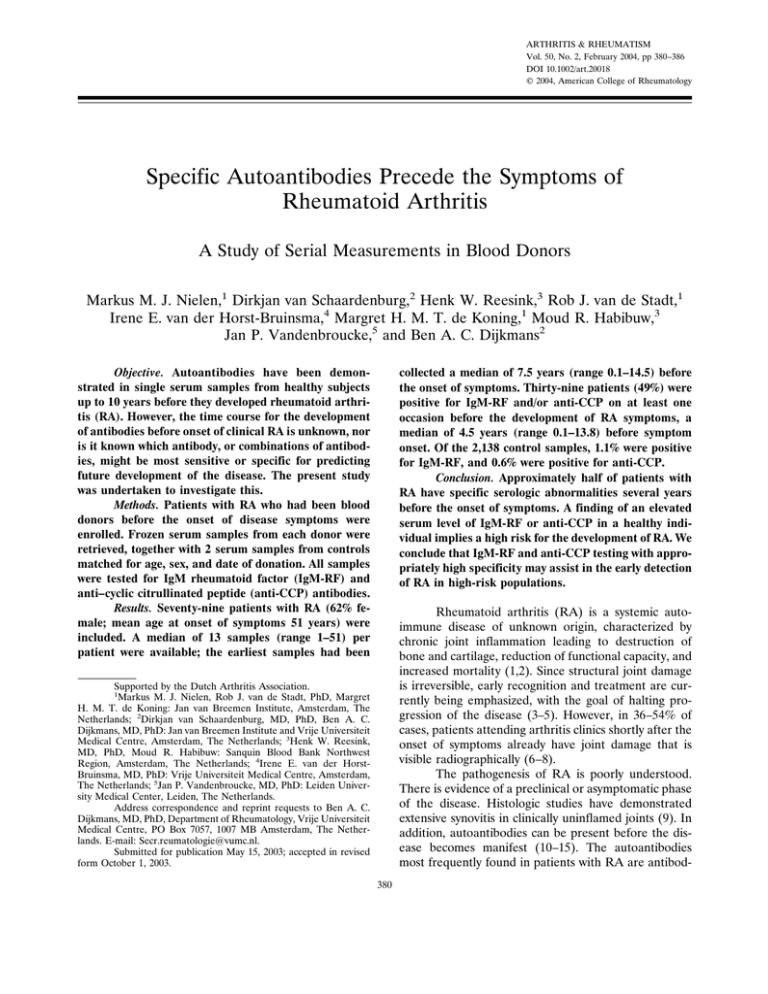
ARTHRITIS & RHEUMATISM Vol. 50, No. 2, February 2004, pp 380–386 DOI 10.1002/art.20018 © 2004, American College of Rheumatology Specific Autoantibodies Precede the Symptoms of Rheumatoid Arthritis A Study of Serial Measurements in Blood Donors Markus M. J. Nielen,1 Dirkjan van Schaardenburg,2 Henk W. Reesink,3 Rob J. van de Stadt,1 Irene E. van der Horst-Bruinsma,4 Margret H. M. T. de Koning,1 Moud R. Habibuw,3 Jan P. Vandenbroucke,5 and Ben A. C. Dijkmans2 collected a median of 7.5 years (range 0.1–14.5) before the onset of symptoms. Thirty-nine patients (49%) were positive for IgM-RF and/or anti-CCP on at least one occasion before the development of RA symptoms, a median of 4.5 years (range 0.1–13.8) before symptom onset. Of the 2,138 control samples, 1.1% were positive for IgM-RF, and 0.6% were positive for anti-CCP. Conclusion. Approximately half of patients with RA have specific serologic abnormalities several years before the onset of symptoms. A finding of an elevated serum level of IgM-RF or anti-CCP in a healthy individual implies a high risk for the development of RA. We conclude that IgM-RF and anti-CCP testing with appropriately high specificity may assist in the early detection of RA in high-risk populations. Objective. Autoantibodies have been demonstrated in single serum samples from healthy subjects up to 10 years before they developed rheumatoid arthritis (RA). However, the time course for the development of antibodies before onset of clinical RA is unknown, nor is it known which antibody, or combinations of antibodies, might be most sensitive or specific for predicting future development of the disease. The present study was undertaken to investigate this. Methods. Patients with RA who had been blood donors before the onset of disease symptoms were enrolled. Frozen serum samples from each donor were retrieved, together with 2 serum samples from controls matched for age, sex, and date of donation. All samples were tested for IgM rheumatoid factor (IgM-RF) and anti–cyclic citrullinated peptide (anti-CCP) antibodies. Results. Seventy-nine patients with RA (62% female; mean age at onset of symptoms 51 years) were included. A median of 13 samples (range 1–51) per patient were available; the earliest samples had been Rheumatoid arthritis (RA) is a systemic autoimmune disease of unknown origin, characterized by chronic joint inflammation leading to destruction of bone and cartilage, reduction of functional capacity, and increased mortality (1,2). Since structural joint damage is irreversible, early recognition and treatment are currently being emphasized, with the goal of halting progression of the disease (3–5). However, in 36–54% of cases, patients attending arthritis clinics shortly after the onset of symptoms already have joint damage that is visible radiographically (6–8). The pathogenesis of RA is poorly understood. There is evidence of a preclinical or asymptomatic phase of the disease. Histologic studies have demonstrated extensive synovitis in clinically uninflamed joints (9). In addition, autoantibodies can be present before the disease becomes manifest (10–15). The autoantibodies most frequently found in patients with RA are antibod- Supported by the Dutch Arthritis Association. 1 Markus M. J. Nielen, Rob J. van de Stadt, PhD, Margret H. M. T. de Koning: Jan van Breemen Institute, Amsterdam, The Netherlands; 2Dirkjan van Schaardenburg, MD, PhD, Ben A. C. Dijkmans, MD, PhD: Jan van Breemen Institute and Vrije Universiteit Medical Centre, Amsterdam, The Netherlands; 3Henk W. Reesink, MD, PhD, Moud R. Habibuw: Sanquin Blood Bank Northwest Region, Amsterdam, The Netherlands; 4Irene E. van der HorstBruinsma, MD, PhD: Vrije Universiteit Medical Centre, Amsterdam, The Netherlands; 5Jan P. Vandenbroucke, MD, PhD: Leiden University Medical Center, Leiden, The Netherlands. Address correspondence and reprint requests to Ben A. C. Dijkmans, MD, PhD, Department of Rheumatology, Vrije Universiteit Medical Centre, PO Box 7057, 1007 MB Amsterdam, The Netherlands. E-mail: Secr.reumatologie@vumc.nl. Submitted for publication May 15, 2003; accepted in revised form October 1, 2003. 380 IgM-RF AND ANTI-CCP PRECEDE RA SYMPTOMS ies against IgG (IgM rheumatoid factor [IgM-RF]) and antibodies against citrullinated proteins. The latter were originally measured as antibodies against keratin or filaggrin and more recently as anti–cyclic citrullinated peptide (anti-CCP) (16,17). In hospital-based groups of patients with early RA, the prevalence of RF is 50–66%, and the prevalence of anti-CCP is 41–48%; the prevalence rates of these antibodies in the absence of disease are reported to be 7–13% and 3–9%, respectively (17–19). A number of reports have described the presence of autoantibodies in the blood of apparently healthy persons years before they developed RA. This was found not only in populations at increased risk for RA, such as multicase families (10,15) or Pima Indians (14), but also in the general populations of Finland (11,12) and Iceland (13). Most of the results were based on findings in single serum samples and therefore provide no information about the course of autoantibody titers in the period before the onset of symptoms of RA or about which antibodies might be most sensitive and specific to predict the disease. In the present study, the pattern of autoantibodies in the preclinical phase of RA was investigated with serial measurements, using highly specific tests, of IgM-RF and anti-CCP in blood donors before they developed RA and in control blood donors who did not develop RA. PATIENTS AND METHODS Study subjects. Since 1984, the Sanquin Blood Bank Northwest Region (formerly Red Cross Blood Bank) in Amsterdam has stored (at ⫺30°C) 1-ml aliquots of serum from donated blood. The majority of the donors, who are age ⱕ70 years, donate 2–4 times per year over periods of several years. The bank serves an area with approximately 2 million inhabitants. Within this area, most RA patients are registered at the Jan van Breemen Institute, a regional network of outpatient clinics. In 1999, a letter was sent to all 5,000 registered patients with RA in the diagnosis registry of the Jan van Breemen Institute, asking whether they had donated blood at the Sanquin Blood Bank Northwest Region since 1984, but before the onset of their symptoms of RA. The diagnosis registry also includes cases in which the diagnosis is not entirely certain; therefore, the charts of the responding patients were reviewed for the fulfillment of the American College of Rheumatology (ACR; formerly, the American Rheumatism Association) 1987 criteria for RA (20). Of the 153 responding patients, 74 were excluded: all blood donation had occurred before 1984 in 35, 17 had donated at another blood bank, 18 did not fulfill the ACR criteria for RA, and medical records were unavailable for 4. The study was carried out with the 79 remaining patients. Thus, exclusions were due only to uncertainty about the diagnosis or unavailability of specimens. There were no familial relationships among the 79 patients. 381 The following data were collected from medical records: time of the start of symptoms, date of the diagnosis of RA according to the ACR criteria, IgM-RF status, erythrocyte sedimentation rate, use of disease-modifying antirheumatic drugs, and presence of bony erosions seen on radiographs. IgM-RF tests on samples provided before symptom onset (subject of the present study) and during followup after diagnosis were performed in the same way. Anti-CCP was not routinely tested in the clinic during the period the patients were followed up. Since the start of the early arthritis clinic in 1995, the time of the start of symptoms was also checked by a research nurse in 22 patients (28%). The study was approved by the local Institutional Review Board. Procedures. Serum aliquots of blood from each blood collection site had been stored in one stoppered container per day, each containing 50–100 vials and marked with a job number. A computer program was developed to trace all blood donations from a particular RA patient in the period 1984– 1999 and to locate a serum vial in a particular container. For each RA sample, 2 masked control samples from the same container were selected, matched for sex, age (⫾3 years), and time of blood donation. This method of control selection was chosen to ensure identical storage conditions for the samples from patients and controls. The ability to find the correct serum samples was validated in pilot experiments. The quality of the selected samples was checked by measuring sodium concentration in 106 randomly selected control samples. The mean ⫾ SD sodium concentration was 140.3 ⫾ 4.8 mmoles/ liter; this distribution is similar to that in freshly collected sera from a normal adult population, indicating that evaporation during storage had not occurred. IgM-RF and anti-CCP antibodies were measured using in-house enzyme-linked immunosorbent assays and an ES 300 analyzer (Roche Diagnostics; Mannheim, Germany). Biotinylated rabbit IgG and, at the N-terminus, biotinylated citrullinated peptides (cyclic and with the amino acid sequence as described by Schellekens et al [18]) were bound to streptavidin-coated walls. After incubation with diluted serum, wells were developed using horseradish peroxidase– conjugated F(ab)2 (Dako; Glostrup, Denmark) directed against human IgM and IgG. The day-to-day coefficients of variation in a weakly positive internal control serum sample were 4.8% and 4.2% for IgM-RF and anti-CCP, respectively (n ⫽ 50 days). IgM-RF was calibrated with a national reference serum containing 200 IU/ml (21); no such standard serum is available for anti-CCP. The criteria for recording a value as being positive were ⱖ30 IU/ml for IgM-RF and ⱖ50 arbitrary units/ml for anti-CCP, based on the findings in 2 cohorts. In cohort 1, which consisted of sera from 239 patients with RA that was in clinical remission, 55 patients with active RA from our outpatient clinic (22), and 187 control sera, the sensitivity with these criteria was 48.5% for IgM-RF and 49% for anti-CCP, with a specificity of 95.3% for IgM-RF and 98.9% for anti-CCP. Cohort 2 consisted of the baseline sera from patients with early arthritis. After 1 year, 258 patients had RA and 121 were classified as having undifferentiated polyarthritis (19). In that cohort, the sensitivity was 50.4% for IgM-RF and 42.6% for anti-CCP, with a specificity of 93.4% for IgM-RF and 97.5% 382 NIELEN ET AL for anti-CCP. The cutoff values were deduced from receiver operating characteristic curve analysis. Statistical analysis. For each RA patient, antibody concentrations over time were plotted. In a first analysis, for blood donors who were positive at least once for IgM-RF and/or anti-CCP before the start of symptoms, the times of the first positive test result for IgM-RF, the first positive test result for anti-CCP, and the first positive test result for IgM-RF and/or anti-CCP were determined. Patients were considered to be positive for these parameters from that time onward. Thus, the cumulative prevalence of positivity over the period before the onset of symptoms was measured. The frequency of positive test results and the median time between the first positive test results and the start of symptoms were calculated for the group of donors who developed RA. In a second analysis, the time axis was divided into 15 1-year periods preceding the onset of symptoms. Period 1 covered the blood donations made within 1 year before the onset of symptoms, period 2, between 1 and 2 years, etc. For each period, the sensitivity and specificity of IgM-RF, antiCCP, and IgM-RF and/or anti-CCP were measured by calculating the percentage of positive samples from blood donors who developed RA and the percentage of negative samples in the matched controls. Next, the positive predictive value (PPV) and negative predictive value of the serologic tests for a period of 5 years before the onset of symptoms were calculated. The results also were used to estimate the 5-year risk of developing RA in 1) the general population and 2) a high-risk population of multicase families, using 5-year incidence figures. The estimates we used for overall risk of RA development within 5 years were 1 per 1,000 in the general Dutch population (23) and 39 per 1,000 in multicase families (10). Finally, the statistical significance of the differences in various characteristics between the group of patients who were antibody positive and those who were antibody negative prior to symptom onset was determined. The groups were compared using Student’s t-test, the Mann-Whitney U test, or the chisquare test, as appropriate. Table 1. Characteristics of 79 blood donors who developed rheumatoid arthritis % women Age at onset of symptoms, mean ⫾ SD years Time between onset of symptoms and diagnosis, median (range) years Radiographic erosions at first visit, no. of patients Radiographic erosions at last followup, no. of patients Duration of followup after onset of symptoms, median (range) years 62 51.4 ⫾ 11.1 0.9 (0.1–6.5) 25 48 5.6 (0.7–15.6) Test results. Of the 2,138 control samples, 24 (1.1%) were positive for IgM-RF (specificity 98.9%), 12 (0.6%) for anti-CCP (specificity 99.4%), and 35 (1.6%) for IgM-RF and/or anti-CCP (specificity 98.4%). These specificities were constant over the period of 15 years. A cumulative graph of the percentages of patients who had at least 1 positive test result for IgM-RF, for anti-CCP, and for IgM-RF and/or anti-CCP before the start of symptoms is shown in Figure 1. Twenty-two of 79 patients (27.8%) became IgM-RF positive, and 32 (40.5%) became anti-CCP positive prior to symptom onset; the median time from the first IgM-RF or antiCCP positivity to development of symptoms was 2.0 years (range 0.3–10.3 years) and 4.8 years (range 0.1– 13.8 years), respectively. Thirty-nine patients (49.4%) were positive for IgM-RF and/or anti-CCP at least once, a median of 4.5 years (range 0.1–13.8 years) before the onset of symptoms. (Chart review revealed that the proportion of IgM-RF–positive patients increased to 61% in the 2 years after the first visit to the clinic and to 67% after 6 years. Anti-CCP was not routinely tested in the clinic during the period the patients were followed RESULTS Patient characteristics. Seventy-nine patients (49 women, 30 men) were included; their mean age at the onset of symptoms was 51.4 years (Table 1). At presentation in the clinic 1 year after the development of symptoms, one-third had erosive disease; this proportion had doubled at the last followup. A median of 13 serum samples per patient (range 1–51) were available, the first of which had been obtained a median of 7.5 years (range 0.1–14.5 years) before the onset of symptoms. A total of 1,188 patient sera and 2,358 matched control sera were tested (for 18 patient sera, only 1 control serum meeting the criteria was available). One hundred ten patient samples with 220 matched control samples were not used, because the patient samples were collected after the onset of symptoms. Figure 1. Cumulative percentages of patients with 1 or more positive test results for IgM rheumatoid factor (IgM-RF), anti–cyclic citrullinated peptide (anti-CCP), and IgM-RF and/or anti-CCP before the onset of symptoms of rheumatoid arthritis. IgM-RF AND ANTI-CCP PRECEDE RA SYMPTOMS 383 Figure 2. Patterns of IgM rheumatoid factor (IgM-RF) and anti–cyclic citrullinated peptide (anti-CCP) before the onset of symptoms of rheumatoid arthritis. Titers of IgM-RF and anti-CCP are shown for the period of 10 years before the onset of symptoms. The criteria for positivity (indicated by horizontal lines) were ⱖ30 IU/ml for IgM-RF and ⱖ50 arbitrary units/ml for anti-CCP. up.) After the first positive IgM-RF test result, 98% of the subsequent samples from the same patient yielded positive results. Anti-CCP positivity persisted after the first positive test result in 69.2% of the samples from the same patient. Individual examples of 4 different patterns of presymptomatic IgM-RF and anti-CCP concentrations (either 1 positive, both positive, or both negative) are presented in Figure 2. Nine percent of the patients were positive only for IgM-RF and 21% only for anti-CCP before the start of symptoms. Nineteen percent were positive for both IgM-RF and anti-CCP, and 51% were negative for both tests. The sensitivity of IgM-RF, anti-CCP, and IgM-RF and/or anti-CCP as measured per year over a period of 15 years before the onset of symptoms is shown in Figure 3. There was a gradual increase of the sensitivity of the IgM-RF test over time, with a maximum of Figure 3. Sensitivity (percentage positivity) of IgM rheumatoid factor (IgM-RF), anti–cyclic citrullinated peptide (anti-CCP), and IgM-RF and/or anti-CCP in rheumatoid arthritis patients before the onset of symptoms. 384 NIELEN ET AL Table 2. Diagnostic value of IgM-RF and anti-CCP for RA* Blood donor population 0–5 years before symptom onset IgM-RF Anti-CCP IgM-RF or anti-CCP IgM-RF and anti-CCP Risk of developing RA within 5 years (PPV, %) Sensitivity, % Specificity, % PPV, % NPV, % General population High-risk population† 20.5 28.9 36.5 13.0 98.6 99.5 98.1 100 88.2 96.6 90.6 100 71.1 73.5 75.4 75.4 1.5 5.3 1.9 100 37.7 69.4 43.8 100 * IgM-RF ⫽ IgM rheumatoid factor; anti-CCP ⫽ anti–cyclic citrullinated peptide; PPV ⫽ positive predictive value; NPV ⫽ negative predictive value. † Defined as individuals who have ⱖ2 first-degree relatives with rheumatoid arthritis (RA) (5-year incidence of RA among such individuals has been reported to be 3.9% [10]). 28.5% positivity in the year before the start of symptoms. Anti-CCP was more sensitive than IgM-RF in all time periods except the 9-year pre–symptom onset period, and became positive earlier (maximum 14 years versus 11 years before the start of symptoms). The highest sensitivity for anti-CCP was 31.7%, 2 years before the start of symptoms (a smaller peak occurred at 12 years before symptom onset). The combination criterion of IgM-RF and/or anti-CCP reached a maximum sensitivity of 42.3% in the year before the development of symptoms. The diagnostic characteristics of the tests in the 5 years before the onset of symptoms are summarized in Table 2. The 5-year PPV for anti-CCP in the blood donor population was 96.6%. In the general population, the PPV for anti-CCP was 5.3%, and in a high-risk population, i.e., consisting of persons from multicase families, it was 69.4%. If both IgM-RF and anti-CCP were positive, the PPV was 100%, but the sensitivity decreased to 13%. The risk of developing RA within 5 years (PPV) was higher with anti-CCP alone than with IgM-RF and/or anti-CCP, due to a higher number of controls who were positive for IgM-RF and/or anti-CCP than for anti-CCP alone; the lower PPV is the indirect consequence of the lower specificity of this test combination. The clinical characteristics of patients with and those without a positive test result for IgM-RF and/or anti-CCP before the onset of symptoms are shown in Table 3. The patients with positive serologic results before the onset of symptoms were significantly younger and had a higher frequency of radiographic erosions at last followup, compared with those in whom the results of tests for these antibodies were negative. DISCUSSION Approximately half of 79 blood donors became positive for the autoantibodies IgM-RF and/or anti-CCP before the onset of clinical symptoms of RA. The median time from the first autoantibody positivity in a serum sample to development of symptoms was 4.5 Table 3. Differences between patients with positive serologic findings and those with negative serologic findings before the onset of rheumatoid arthritis symptoms* At first visit % women Age at onset of symptoms, mean ⫾ SD years ESR, median (range) mm/hour Radiographic erosions, no. of patients At last followup† Radiographic erosions, no. of patients No. of prescribed DMARDs, median (range) Prednisone use, no. of patients Positive serologic findings (n ⫽ 39) Negative serologic findings (n ⫽ 40) P 59 48.2 ⫾ 12.2 21 (1–105) 14 65 54.5 ⫾ 9.1 25 (3–106) 9 0.58 0.01 0.71 0.11 30 2 (1–4) 9 20 2 (0–6) 15 0.01 0.73 0.16 * ESR ⫽ erythrocyte sedimentation rate; DMARDs ⫽ disease-modifying antirheumatic drugs. † Median duration of followup 5.6 years (range 0.7–15.6). IgM-RF AND ANTI-CCP PRECEDE RA SYMPTOMS years. Among the patients with antibodies, there was at least 1 positive anti-CCP test result a median of 2.8 years before IgM-RF positivity, but anti-CCP was slightly less likely to remain positive. Both tests were found to be highly specific in this study, which implies a high risk for the development of RA in healthy persons up to age 70 years (the upper age limit of the blood donors) who have elevated serum levels of 1 or both of these antibodies. The group studied appears to be representative of the RA population, based on the age at onset of symptoms, percentage of patients with radiographic erosions at baseline, and frequency of IgM-RF at baseline. The percentage of women in the patient group is somewhat lower than expected, but it is not likely that this influenced the results, since the controls were matched for sex and age. Blood donors are not entirely representative of the general population, because many diseases and infections that increase the risk of a positive IgM-RF test result, such as hepatitis C, lead to exclusion as a donor. This selection might lead to a slightly higher specificity of the IgM-RF test in the studied population. The anti-CCP test might also be influenced by infections such hepatitis C, although a study of antikeratin antibodies (a preliminary anti-CCP test) showed only 8% positivity in hepatitis C–infected patients (24). Our results are in accordance with incidental earlier reports of RF or antikeratin antibodies in both high-risk (10,14,15) and healthy (11–13) populations. However, in the present study we were able to measure antibody levels in serially obtained samples, using 2 different tests that are highly specific for RA. The 44% frequency of positivity for RF in the Finnish population (11) corresponds to our findings, but that study yielded information from only one point in time. Autoantibody positivity prior to symptom development has also been found in other autoimmune diseases, e.g., systemic lupus erythematosus and insulin-dependent diabetes mellitus. Ten of 16 persons who developed systemic lupus erythematosus or mixed connective tissue disease were positive for antinuclear antibodies 0.7–4.5 years before the onset of symptoms (25). Antibodies to glutamic acid decarboxylase, the primary immunologic marker in insulin-dependent diabetes mellitus, were present for up to 10 years in the prediabetic period in 82% of 28 women and in none of 100 controls (26). This led to immunologic interventions to prevent the onset of diabetes in selected populations (27,28). The results of this study shed more light on the time sequence of events in the pathogenesis of RA. An unknown trigger activates B lymphocytes to produce RA-specific antibodies several years before the appear- 385 ance of a level of inflammation that is perceived as symptoms. In the majority of patients, seropositivity, once established, is stable. The production of antibodies in itself is not essential for clinical disease, since it occurred in only half of the patients before onset of symptoms. Still, these patients proved to be the more severely affected in terms of radiologic findings, and the prevalence of antibodies increased over time and was highest in the year before the symptoms appeared. Apparently, the conversion to RF seropositivity continued after the onset of symptoms and reached the commonly reported prevalence level of 67% after 6 years. Apart from providing insight into the pathogenesis of RA, our findings indicate that it may be possible to predict RA development in high-risk populations, as long as appropriately high upper limits of normal are set for the tests used. For example, for multicase families with RA, we have estimated that the 5-year risk of developing RA in a family member with a positive anti-CCP result is 69.4%. We believe this figure is high enough to consider a clinical trial of a medical intervention to prevent the development of RA in these individuals. Because only a small proportion (2–3%) of all patients with RA are from multicase families (29), another possible target group for intervention could be patients with arthralgia and positive serologic findings. In conclusion, half of patients with RA have specific serologic abnormalities years before the development of symptoms. This finding should help guide our understanding of the early phases of RA and may contribute to earlier detection and more aggressive treatment of this disabling disease. ACKNOWLEDGMENTS We gratefully acknowledge the personnel of the Sanquin Blood Bank Northwest Region for their help in obtaining the sera from patients and matched controls, and in particular, Nora Schram for writing the necessary computer programs and setting up the databases. REFERENCES 1. Pincus T, Callahan LF, Sale WG, Brooks AL, Payne LE, Vaughn WK. Severe functional declines, work disability, and increased mortality in seventy-five rheumatoid arthritis patients studied over nine years. Arthritis Rheum 1984;27:864–72. 2. Scott DL, Symmons DP, Coulton BL, Popert AJ. Long-term outcome of treating rheumatoid arthritis: results after 20 years. Lancet 1987;1:1108–11. 3. Van Jaarsveld CH, Jacobs JW, van der Veen MJ, Blaauw AA, Kruize AA, Hofman DM, et al, on behalf of the Rheumatic Research Foundation Utrecht, The Netherlands. Aggressive treat- 386 4. 5. 6. 7. 8. 9. 10. 11. 12. 13. 14. 15. 16. NIELEN ET AL ment in early rheumatoid arthritis: a randomised controlled trial. Ann Rheum Dis 2000;59:468–77. Boers M, Verhoeven AC, Markusse HM, van de Laar MA, Westhovens R, van Denderen JC, et al. Randomised comparison of combined step-down prednisolone, methotrexate and sulphasalazine with sulphasalazine alone in early rheumatoid arthritis. Lancet 1997;350:309–18. Mottonen T, Hannonen P, Leirisalo-Repo M, Nissila M, Kautiainen H, Korpela M, et al, FIN-RACo Trial Group. Comparison of combination therapy with single-drug therapy in early rheumatoid arthritis: a randomised trial. Lancet 1999;353:1568–73. Bukhari M, Harrison B, Lunt M, Scott DGI, Symmons DPM, Silman AJ. Time to first occurrence of erosions in inflammatory polyarthritis: results from a prospective community-based study. Arthritis Rheum 2001;44:1248–53. Combe B, Dougados M, Goupille P, Cantagrel A, Eliaou JF, Sibilia J, et al. Prognostic factors for radiographic damage in early rheumatoid arthritis: a multiparameter prospective study. Arthritis Rheum 2001;44:1736–43. Hulsmans HMJ, Jacobs JWG, van der Heijde DMFM, AlbadaKuipers GA, Schenk Y, Bijlsma JWJ. The course of radiologic damage during the first six years of rheumatoid arthritis. Arthritis Rheum 2000;43:1927–40. Kraan MC, Versendaal H, Jonker M, Bresnihan B, Post WJ, ‘t Hart BA, et al. Asymptomatic synovitis precedes clinically manifest arthritis. Arthritis Rheum 1998;41:1481–8. Silman AJ, Hennessy E, Ollier B. Incidence of rheumatoid arthritis in a genetically predisposed population. Br J Rheumatol 1992;31:365–8. Aho K, Heliovaara M, Maatela J, Tuomi T, Palosuo T. Rheumatoid factors antedating clinical rheumatoid arthritis. J Rheumatol 1991;18:1282–4. Kurki P, Aho K, Palosuo T, Heliövaara M. Immunopathology of rheumatoid arthritis: antikeratin antibodies precede the clinical disease. Arthritis Rheum 1992;35:914–7. Halldorsdottir HD, Jonsson T, Thorsteinsson J, Valdimarsson H. A prospective study on the incidence of rheumatoid arthritis among people with persistent increase of rheumatoid factor. Ann Rheum Dis 2000;59:149–51. Del Puente A, Knowler WC, Pettitt DJ, Bennett PH. The incidence of rheumatoid arthritis is predicted by rheumatoid factor titer in a longitudinal population study. Arthritis Rheum 1988;31: 1239–44. Walker DJ, Pound JD, Griffiths ID, Powell RJ. Rheumatoid factor tests in the diagnosis and prediction of rheumatoid arthritis. Ann Rheum Dis 1986;45:684–90. Schellekens GA, de Jong BA, van den Hoogen FH, van de Putte LB, van Venrooij WJ. Citrulline is an essential constituent of 17. 18. 19. 20. 21. 22. 23. 24. 25. 26. 27. 28. 29. antigenic determinants recognized by rheumatoid arthritis-specific autoantibodies. J Clin Invest 1998;101:273–81. Goldbach-Mansky R, Lee J, McCoy A, Hoxworth J, Yarboro C, Smolen JS, et al. Rheumatoid arthritis associated autoantibodies in patients with synovitis of recent onset. Arthritis Res 2000;2: 236–43. Schellekens GA, Visser H, de Jong BAW, van den Hoogen FHJ, Hazes JMW, Breedveld FC, et al. The diagnostic properties of rheumatoid arthritis antibodies recognizing a cyclic citrullinated peptide. Arthritis Rheum 2000;43:155–63. Jansen LMA, van der Horst Bruinsma IE, van Schaardenburg D, van de Stadt RJ, de Koning MHMT, Dijkmans BAC. Rheumatoid factor and antibodies to cyclic citrullinated peptide differentiate rheumatoid arthritis from undifferentiated polyarthritis in patients with early arthritis. J Rheumatol 2002,29:2074–6. Arnett FC, Edworthy SM, Bloch DA, McShane DJ, Fries JF, Cooper NS, et al. The American Rheumatism Association 1987 revised criteria for the classification of rheumatoid arthritis. Arthritis Rheum 1988;31:315–24. Klein F, Janssens MB. Standardisation of serological tests for rheumatoid factor measurement. Ann Rheum Dis 1987;46: 674–80. Molenaar ET, Lems WF, Dijkmans BA, de Koning MH, van de Stadt RJ, Voskuyl AE. Levels of markers of bone resorption are moderately increased in patients with inactive rheumatoid arthritis. Rheumatology (Oxford) 2000;39:742–4. Chorus AMJ. Reuma in Nederland: de cijfers. Actualisering 2000. TNO-rapport 2001:27. Kessel A, Rosner I, Zuckerman E, Golan TD, Toubi E. Use of antikeratin antibodies to distinguish between rheumatoid arthritis and polyarthritis associated with hepatitis C infection. J Rheumatol 2000;27:610–2. Aho K, Koskela P, Makitalo R, Heliovaara M, Palosuo T. Antinuclear antibodies heralding the onset of systemic lupus erythematosus. J Rheumatol 1992;19:1377–9. Tuomilehto J, Zimmet P, Mackay IR, Koskela P, Vidgren G, Toivanen L, et al. Antibodies to glutamic acid decarboxylase as predictors of insulin-dependent diabetes mellitus before clinical onset of disease. Lancet 1994;343:1383–5. Carel JC, Boitard C, Eisenbarth G, Bach JF, Bougneres PF. Cyclosporine delays but does not prevent clinical onset in glucose intolerant pre-type 1 diabetic children. J Autoimmun 1996;9: 739–45. Effects of insulin in relatives of patients with type 1 diabetes mellitus. N Engl J Med 2002;346:1685–91. Walker DJ, Griffiths M, Dewar P, Coates E, Dick WC, Thompson M, et al. Association of MHC antigens with susceptibility to and severity of rheumatoid arthritis in multicase families. Ann Rheum Dis 1985;44:519–25.

